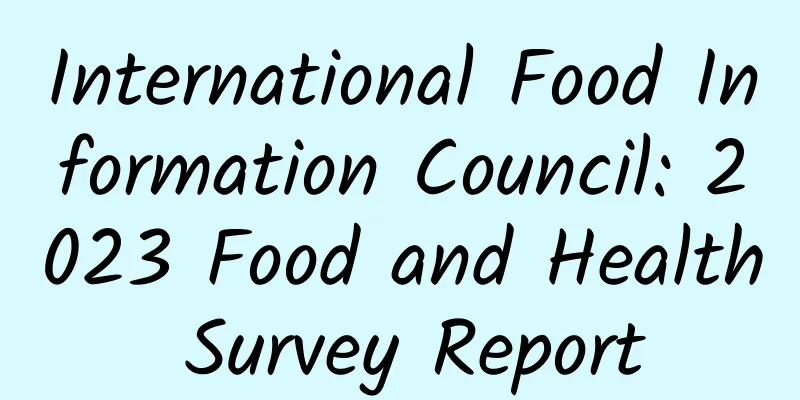International Food Information Council: 2023 Food and Health Survey Report

|
The International Food Information Council released its 2023 Food and Health Survey, with key findings including: Rising food and beverage prices affect shopping behavior for many Americans Three-quarters of Americans (76%) say price has a significant impact on their food and beverage purchasing decisions, an increase from last year’s results (68%). Women (82%) are more likely than men (70%) to say price significantly influences their decisions. Social media content focused on food and nutrition can cause confusion and skepticism Four in 10 Americans (42%) have seen food and nutrition-related content on social media in the past year, with Gen Z (71%) and Millennials (58%) being more likely to be exposed to this content. Food and drink choices are linked to mental and emotional health Three-quarters of Americans (74%) believe the food and beverages they purchase have a major or moderate impact on their overall mental and emotional health. More than six in 10 (61%) also believe their overall mental and emotional health has a major or moderate impact on their food and beverage choices. Gen Z (71%) and Millennials (68%) are more likely than Baby Boomers (56%) to believe their food choices are influenced by their health. Environmental sustainability continues to lag behind other decision-making factors One-third of Americans (34%) say environmental sustainability has a great influence on their food and beverage purchasing decisions, which continues to lag behind other factors. Similarly, 35% say a product’s climate friendliness influences their purchasing decisions. Millennials are most likely to care about this issue (46%), followed by Gen Z at 39%, Gen X at 38% and Baby Boomers at 22%. About half of Americans have followed a dietary pattern in the past year In line with last year’s survey, 52% of Americans followed a specific eating pattern or eating habits in the past year. Gen Z (66%) and Millennials (63%) are more likely to follow a eating pattern or eating habits than Gen X (50%) and Baby Boomers (41%). Snacking frequency rises for second consecutive year Seven in 10 Americans (72%) snack at least once a day outside of a meal, a finding consistent with last year’s survey (73%). The most common reason for snacking is hunger or thirst, which has increased since 2022, from 34% to 41%. Other top reasons for snacking include thinking that snacking is a treat (29%) and craving sweet (21%) and salty (21%) snacks. Most Americans confident in safety of food supply, but more education would be helpful Seven in 10 Americans (70%) feel “very” or “somewhat” confident in the safety of the U.S. food supply, a finding similar to the 2022 results (68%). Interestingly, Baby Boomers (77%), Gen X (70%) and Millennials (70%) are more likely to feel confident than Gen Z, of which less than half (44%) feel confident. More Americans are willing to pay a premium for socially sustainable products More than four in ten Americans (46%) say that fair and equitable treatment of workers who produce, distribute or serve the food they eat is an important factor in their decisions about what food or beverages to buy. |
<<: Android L update is coming but when can you enjoy it?
>>: iPhone 6 won’t be sold in China: Apple, please tell me something
Recommend
SMMT: Tesla's sales in February 2025 increased by 20.7% year-on-year, and its market share increased by 4.6%
Tesla's sales in the UK rose by more than a f...
Do a good job of scene marketing and let users chase your activities
Have you all been flooded with Wu Yifan's Fre...
A complete guide to marketing on Xiaohongshu!
Before major marketing events, how to quickly and...
These 30 copywriting sentences are worth 30,000
Different classic copywriting has the same senten...
The dirty tricks ransomware uses to fool us
[[167210]] Finding ransomware... Today, ransomwar...
“Meituan Takeout” product analysis report!
Take-out has become a must-have for urbanites, sa...
Can you do scientific experiments at home? Come and find out!
As people's living conditions are getting bet...
SKYWORTH 55G9200 Geek TV Review: Sound, Picture and Game
1. Evaluation Introduction Skyworth recently laun...
Hesai Technology's LiDAR was found to have a "leap year bug", and the company said it would solve the problem within 24 hours
It is reported that because Hesai Technology'...
Programming language rankings in September 2017: How long can the three giants Java, C and C++ dominate the rankings?
[51CTO.com Quick Translation] For the past 16 yea...
Xiaohongshu promotion method and Xiaohongshu ranking skills!
Today I will talk about how to promote Xiaohongsh...
An introduction to Kugou advertising promotion styles and material specifications!
Kugou is Tencent’s first social karaoke applicati...
IEA: Boosting private investment in clean energy in emerging and developing economies
The IEA has published a report titled "Boost...
How to optimize 360 bidding keyword ranking? What are the precautions?
For bidding promotion personnel, in addition to B...
4 tips from a 30-year veteran for game developers
I recently left the software development industry...









